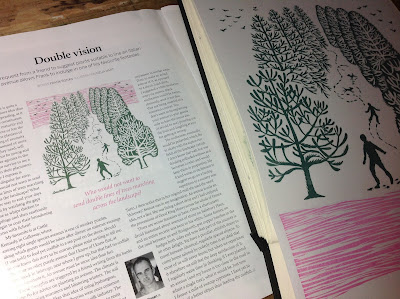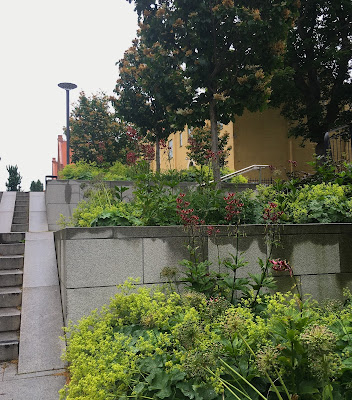Here is my round-up of the linocut illustrations for Frank Ronan's monthly column in Gardens Illustrated magazine for July to December 2017 (the illustrations for January to June can be found
here).
Frank's June column left him returning home after a few years living in California ...
"The joy of being back in my own garden is overwhelming at times."
During 2016 Frank's writing had taken on a gloomy tone, so I was relieved he was happy and and back among plants he loves ... and I love too.
July 2017
Frank's garden has been left to grow wild and he's unsure what to tackle first. He decides that a large fir tree ... a Christmas tree someone planted out in the 1950s ... now dwarves the cottage and has to go; his decision made because he loves pruning things, climbing trees and using a chain saw. The fir tree's trunk already has a Clematis montana growing up it, so Frank leaves a 15 ft stump as its support. Our garden wall also has a C. montana ... and as it was May it was in flower (I work about 2 months ahead of publication), so I could enjoy sketching from life. This isn't always possible but I prefer drawing from real live plants.
August 2017
This year I often had a very small window when I could work on the 'Frank' illustrations; the August Frank arrived in late May and I sat at my desk and carefully read and re-read Frank's words on Monday 5 June ... 2 days after the London Bridge attack, the 3rd terrorist attack in a only a few weeks last summer. Frank's essay on the subject of forgiveness, contentment and happiness was poignant and perfectly timed ... I may have cried (which doesn't happen often). If you have a copy of the the magazine or can get the online version, I recommend it as something to keep at hand if times get tough.
The editor suggested I include a Goldfinch in the composition, they are frequent visitors to our garden and one of my favourite birds, so along with grasses I sketched from life this became the image to illustrate Frank's words ...
"Happiness is no right, but an elusive privilege ... If you chase it, it will run ... The stiller you are the more it will linger. Any attempt to run after it and capture it, or even too direct a stare, and it will flit off like a goldfinch startled."
September 2017
More happy coincidences for September's Frank, the subject is meadows and I'd just spent
a fascinating day visiting one and doing lots of sketches. Frank had been reading a book, 'Grass-fed Nation' by Roger Harvey, the agricultural adviser for 'The Archers' ... which is often on the radio as I work ... so I'm familiar with 'herbal leys'.
Frank discovers that his neglected garden borders ... now overgrown with a thatch of grasses, wildflowers and self-seeded perennials related to meadow plants ... are thriving! He muses about a new kind of garden border that is more like a meadow. Now, that sounds lovely, just my kind of thing too, Knapweeds, Burnets and Geraniums mingled in drifts of meadow grasses ... something butterflies would enjoy too.
October 2017
Autumn flowering bulbs is the subject of the October 'Frank', all those lovely sugar-almond pink flowers that surprise the garden with their clean sharp colour among the decaying leaves of autumn.
I chose to illustrate the Nerines and Cyclamen (Frank includes Colchicums too, but I decided they would overload the illustration). I included the toad that Frank says looks like a Cyclamen corm, and the drifts of Cyclamen are based on those at
Anglesey Abbey which have a special memory for me.
I like his idea of planting Nerines in pots ... so this is a visual reminder to do that too.
November 2017
Apple trees and garden bonfires ... two more things I can draw from life and from personal experience. Frank is writing about how picking fruit and having a bonfire are great ways to get friends to 'help' in the garden. This was a lovely Autumnal subject and and excuse to carve decorative patterns to depict the flames and smoke.
December 2017
The December issue of Gardens Illustrated includes a lovely new series of articles by Lia Leendertz on identifying trees, part 1 covers Deciduous Native British Trees. To continue the 'tree theme', Frank writes about Ash trees at a time when time may be running out as they succumb to Ash Die-Back. The Ash tree I sketched for this illustration is one I can see from our vegetable plot, it stands on the bank of the brook in the neighbour's garden, and has a twin trunk which joins to make an opening big enough for a child for small person to squeeze through.
I've got used to spotting obscure literary references in Frank's writing, this month he makes a passing reference to Tennyson referring to the Ash tree's 'coal black buds in March' ... it took a request on Twitter for someone to point me to
'The Gardener's Daughter', so I thought a 2017 gardener's daughter should appear in the picture ... with her cat. The door in the garden wall is based on the one in my garden ... although I've played around with the scale and made the tree huge and the wall more extensive and further away.
A few more changes from the usual ... I worked slightly larger and inked the block in various shades of brown and dark grey. The red of the gardener's daughter's coat was added digitally after scanning the print (if I print an edition, I'll cut a special block to print the red).
So that's almost another year of prints complete ... there's one more, I'll tell you about the linocut for the Special 'Plants Edition' before the New Year.
Meanwhile, wishing you a calm run-up to the Christmas weekend.
Cheers!
Celia
xx




























































